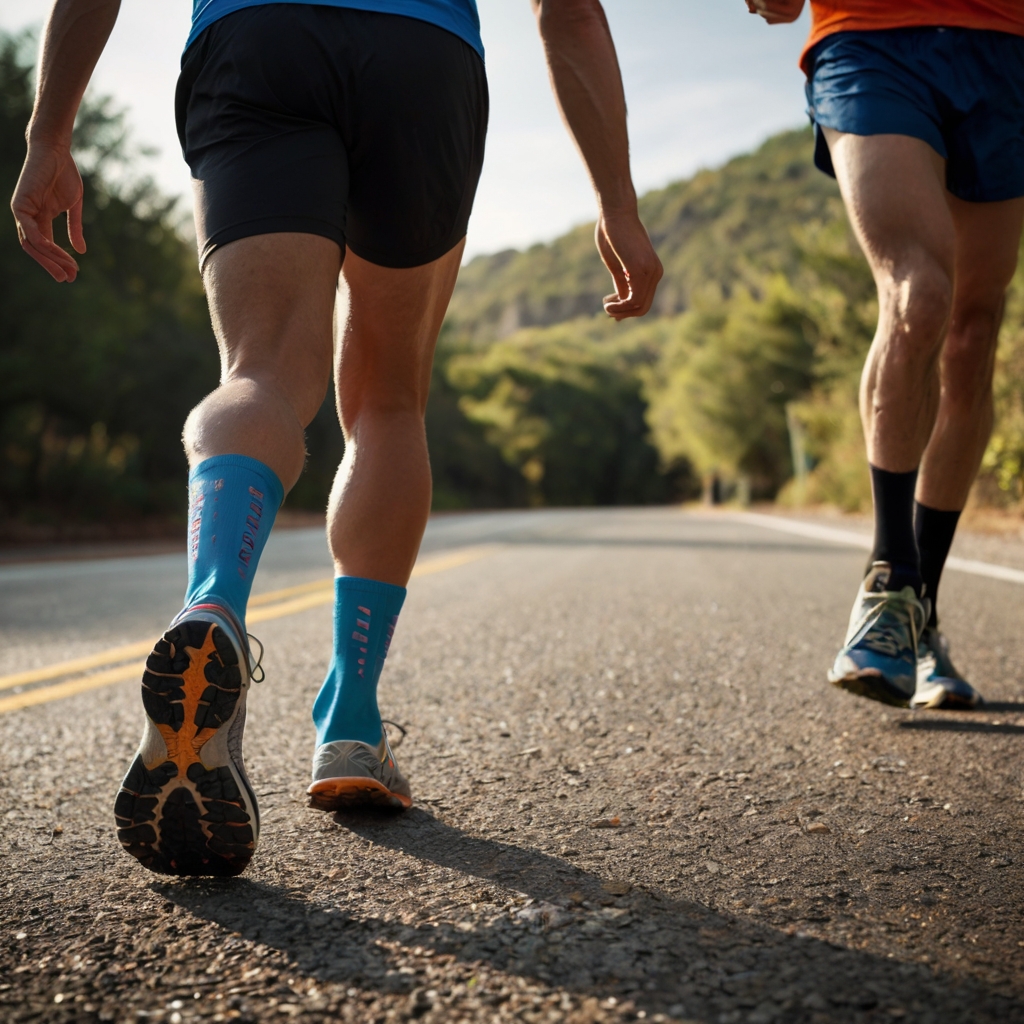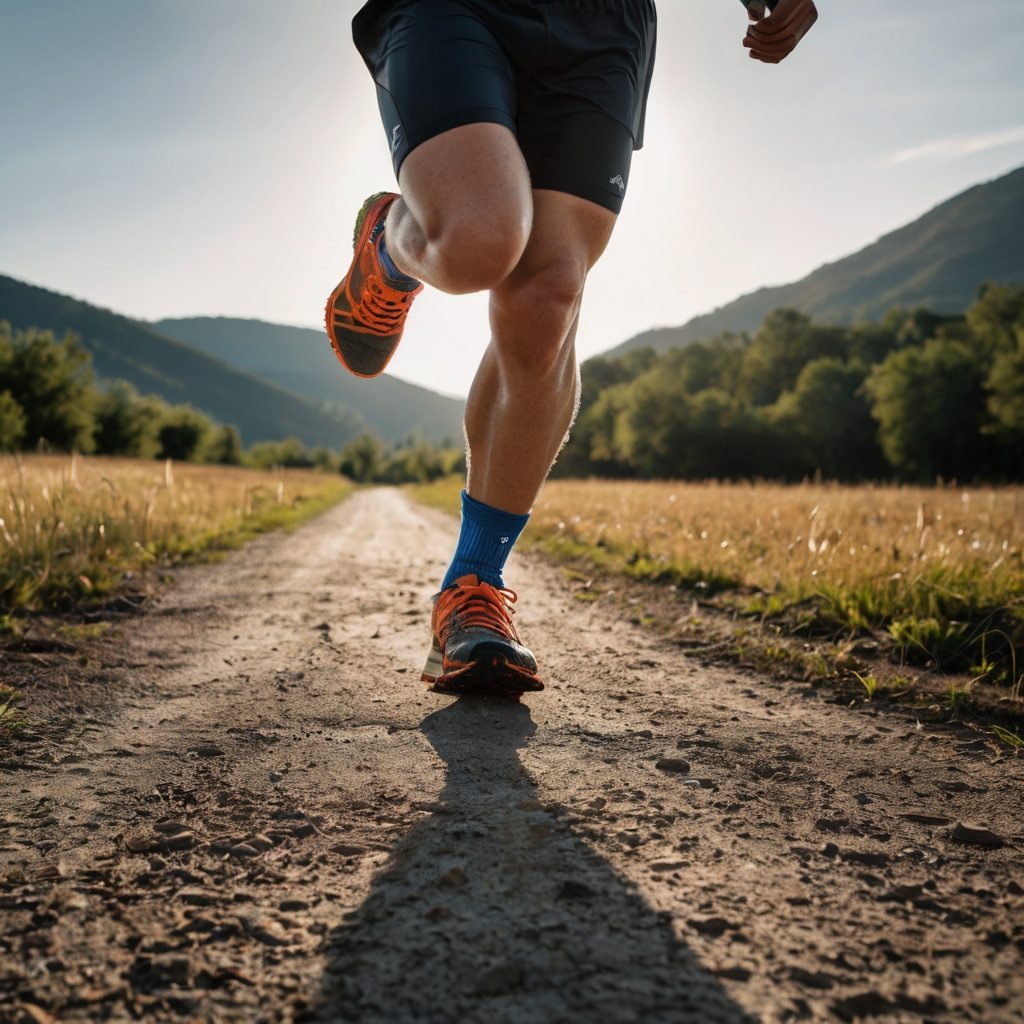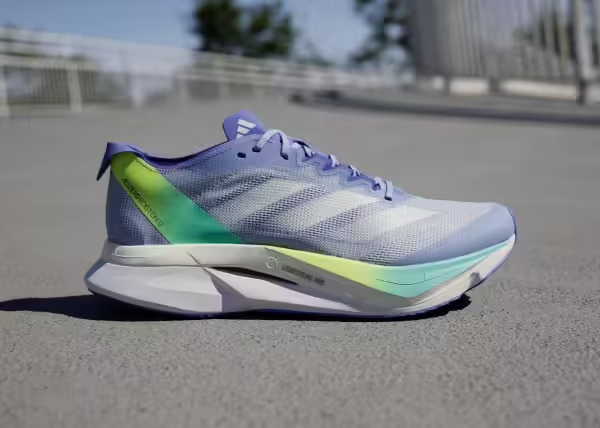Running athletes cover hundreds of miles monthly, which makes quality running socks a significant piece of gear rather than an afterthought. Simple cotton socks hold moisture that causes blisters, but technical running socks now use advanced materials designed specifically for performance.
Professional athletes know that the right running socks can affect their performance, comfort, and protection during training and races. These specialized socks combine moisture-wicking synthetic fabrics like merino wool and LYCRA® with targeted compression zones and strategic ventilation. This design prevents blisters and reduces muscle fatigue effectively. Premium options cost more than $20 but provide increased durability and technical features that make them worth the investment for both recreational and competitive runners.
Table of Contents
- 1
- 2 Why Elite Athletes Prioritize Running Sock Selection
- 3 Best Running Socks for Different Racing Disciplines
- 4 Technical Features Pro Athletes Look For
- 5 Pro Athletes’ Favorite Running Socks Reviewed
- 6 How Running Socks Impact Recovery
- 7 FAQs about the best socks for running:
- 7.1 What type of socks is best for running?
- 7.2 Is it better to run with thick or thin socks?
- 7.3 Do elite marathon runners wear socks?
- 7.4 Is it better to run with long or short socks?
- 7.5 Are thick or thin running socks better?
- 7.6 Why are Nike Dri-Fit socks so popular?
- 7.7 Are thicker socks better for sweaty feet?
- 7.8 Are tighter socks better for running?
- 7.9 What are the best exercise socks?
Why Elite Athletes Prioritize Running Sock Selection
Professional athletes know that great running performance begins with their feet. Research shows that technical running socks can make a real difference in muscle activation and boost movement economy.
Impact on performance metrics
Technical running socks play a direct role in athletic performance through smart design features. High-end running socks use dense thread counts that create finer materials to match your foot’s natural shape. On top of that, it uses different compression levels to improve fit and boost muscle fiber recruitment. Research shows that well-designed running socks can change biomechanics and help improve movement economy.
Injury prevention benefits
Athletes at the pro level choose running socks mainly for protection. These technical socks keep feet dry and cool with moisture-wicking features, so there’s less chance of blisters forming. The socks come with seamless toe design and padding in high-impact zones. Advanced models have:
- Fits that match your foot’s natural shape
- Anti-blister tech with moisture-wicking properties
- Extra padding in heel and toe areas
- Mesh zones to control temperature
Recovery optimization
Research backs the recovery benefits of specialized running socks. Studies show that compression socks help reduce muscle soreness and fatigue after exercise. Blood flows better toward the heart as compression technology gently squeezes muscles. This improved blood flow brings more oxygen and nutrients to muscles, which speeds up recovery.
Recent scientific studies confirm that athletes feel less muscle pain and inflammation when they wear compression socks after working out. These benefits work for everyone – not just elite athletes. Even casual runners see better recovery numbers within 24-48 hours after exercise.
Best Running Socks for Different Racing Disciplines
The right running socks can improve your performance and comfort based on your racing discipline. Each racing environment needs specific sock features to help you run better.
Marathon and ultra-distance recommendations
Long-distance runners need socks that manage moisture well and last longer. The Injinji Ultra Run series excels with its cushioned terry throughout the foot and individual toe wrapping in COOLMAX fibers. Balega’s Blister Resist Quarter socks feature mohair blend technology that reduces friction and wicks away moisture quickly.
Ultra-distance events see runners choosing between two popular brands at the Western States 100-Mile Ultramarathon – Injinji and Dry Max. These brands make socks with targeted cushioning and moisture-wicking fabrics perfect for endurance runs.
Trail running specific features
Trail running needs socks that protect and last longer. Here’s what trail running socks include:
- Zoned mesh panels that help with airflow and moisture control
- Higher sock heights (quarter or crew) to keep debris and scratches away
- Merino wool blends that regulate temperature and fight odor
- Stronger heels and toes that handle rough terrain better
Smartwool PhD Run socks work great on trails. They come with mesh ventilation zones and keep your feet at the right temperature. These features help prevent blisters and keep you comfortable on any terrain.
Track and speed workout essentials
Track athletes and speed runners need light socks that help them feel the ground better. Stance Run Light Crew socks have no seams and breathe well, making them perfect for intense workouts.
Speed workouts need socks with arch compression and minimal cushioning to maintain shoe response. The Speed Crew Sock delivers with its fitted arch and strategic micro-cushioning zones.
Each racing type needs specific sock features to help you perform better. Ultra runners need moisture control and cushioning. Trail runners need protection and durability. Track athletes want lightweight construction and responsiveness. The secret is matching your socks to what your racing environment demands.

Technical Features Pro Athletes Look For
Breakthroughs in technology shape how manufacturers develop specialized running socks. Companies invest heavily in research and testing to create better products.
Advanced moisture wicking technology
Today’s running socks go beyond simple wicking with sophisticated moisture management systems. Synthetic materials like polyester and nylon push moisture away and move sweat to the fabric’s exterior where it evaporates quickly. Tests show that advanced treatments like Dry1st® technology remove moisture five times faster than standard options.
Merino wool blends excel at moisture control because of their natural ability to regulate temperature and resist odors. These fibers work with synthetic materials to create an effective moisture management system that keeps feet dry during long runs.
Strategic compression zones
Quality running socks have engineered compression zones that work on specific muscle groups. These zones provide 18 to 20 mmHg of compression around the arch and ankle to support runners without limiting their movement.
The compression zones are placed strategically:
- Arch support zones reduce muscle fatigue
- Ankle zones boost balance awareness
- Graduated compression from ankle to calf improves blood flow
- Cushioning zones protect against impact
Durability factors
Top running socks are built to last through advanced construction methods. Dense, stronger materials come from higher needle counts, while manufacturers mix specialized fibers to reduce wear patterns. Good running socks keep their performance features for several years before losing elasticity.
Taking care of these socks properly makes them last longer. Washing in cold water and drying with low heat helps preserve their technical features. Some brands like Darn Tough are so confident in their construction that they offer lifetime guarantees on their products.
Pro Athletes’ Favorite Running Socks Reviewed
Athletes and running experts have tested many sock models to find the best options for runners of all types. After testing in ground conditions, some brands consistently perform better than others.
Best running socks for men
The Balega Enduro is a top choice for male runners. It uses Drynamix polyester yarn that provides excellent moisture control and cushioning. The sock’s deep heel pocket and exact fit stop any movement inside running shoes. This benefits runners who log high weekly mileage.
The Darn Tough Run Ultra-Light gives you amazing durability with its high stitch count construction. Runners looking for long-term value will love these socks. They keep performing well even after heavy use and come with a lifetime guarantee against wear and tear.
Best running socks for women
Female athletes tend to choose Bombas Performance Compression socks with their cushioned areas and bright color options. These socks deliver between 20-30 mmHg of compression. They support your feet without feeling too tight.
CEP Run No Show socks have become popular with women runners. An 89% Polyamide and 11% Elastane blend gives excellent stability and ankle support. Yes, it is impressive how these socks keep their shape through many uses and washes.
Best compression socks for running
CEP Tall Compression Socks 4.0 improve blood flow and reduce muscle fatigue. These socks offer:
- Graduated Compression: 20-30 mmHg at the ankle, decreasing gradually up the leg
- Strategic Support: Targeted compression in arch and ankle zones
- Recovery Enhancement: Improved circulation for faster muscle recovery
- Moisture Management: Ventilated footbed for temperature regulation
2XU Compression Socks for Recovery are another great performer. They use graduated compression that puts the most pressure at the ankle and less towards the calf. This design helps blood flow and prevents swelling during long-distance runs.
Compression technology in running socks has improved by a lot. Research shows that wearing compression socks for 24 to 48 hours after workouts can speed up recovery times. Pro athletes usually pick compression levels between 20 and 30 mmHg because this range gives firm support without limiting circulation.
How Running Socks Impact Recovery
Scientific research continues to confirm how specialized running socks play a crucial role in post-exercise recovery and injury prevention. Studies show that compression socks help runners achieve measurable improvements in muscle function and comfort during recovery periods.
Post-run recovery benefits
Runners who wear compression socks show 34.6 – 42.3% lower recovery variables at 24 hours and an impressive 40.3 – 61.4% lower recovery variables at 48 hours compared to those without compression gear. These benefits aren’t just for elite athletes – recreational runners also see notable improvements in their recovery metrics.
The core recovery advantages include:
- Less muscle soreness and fatigue
- Reduced swelling in feet and lower legs
- Better blood circulation for faster healing
- Better muscle power preservation
We found that runners who wore compression socks after a 10km run kept their explosive power. However, those wearing regular socks showed a drop in vertical leap height. These socks work great for athletes who need to prepare for back-to-back training sessions or multi-day events.
Compression technology science
Compression socks work through graduated pressure application. The strongest compression starts at the ankles and gradually decreases up the leg. This design creates positive pressure across blood vessel valves that promotes better circulation and helps remove waste products.
Research shows compression socks help reduce creatine kinase concentration – a biomarker for muscle damage. These socks boost the veinous return system when worn during exercise or recovery periods and prevent fluid from pooling in the lower extremities.
Injury prevention features
Compression running socks offer specific protective features that regular athletic socks don’t have. These features help lower injury risks. Trail runners who regularly wore compression socks during training reported fewer seasonal injuries.
The protective mechanisms work in several ways. The socks limit muscle oscillation during impact and reduce microtrauma to muscle tissue. This decreased muscle vibration helps prevent exercise-induced damage, whatever the running distance.
Research from the Boston Marathon showed that runners wearing compression socks after the race had reduced clotting mechanisms compared to those in standard socks. This benefit helps athletes who travel more than an hour after races since the compression technology supports proper blood circulation during long periods of sitting still.
The recovery benefits go beyond immediate post-run advantages. Athletes who use compression socks report better proprioception – their body’s awareness of position and movement. This improved sensory feedback helps with balance and coordination and reduces injury risks in future training sessions.
Technical running socks are vital gear for athletes at every level. Scientific research and professional endorsements back this claim. Research shows how these socks affect performance metrics, recovery times, and help prevent injuries.
Professional athletes pick specific sock features based on their racing style. Ultra runners need moisture control and cushioning. Trail runners look for better protection. Track athletes prefer lightweight responsiveness. Advanced compression technology and specialized designs lead to better muscle activation and movement economy.
Research proves that good running socks cut recovery times by 61.4% within 48 hours after exercise. Moisture-wicking materials, targeted compression zones, and anatomic fit work together. These features create the perfect environment for peak performance and quick recovery.
Athletes should think over their specific running needs when picking socks. Premium options cost more upfront but last longer and pack technical features that boost both performance and protection. The right pair of running socks isn’t just an accessory – it’s a vital part of athletic success and a great way to get more from your running gear.
FAQs about the best socks for running:
What type of socks is best for running?
The best socks for running provide comfort, moisture-wicking, and blister prevention. Look for options like the best running socks for men and women that use breathable materials such as merino wool or synthetic blends. The best compression socks for running can also improve circulation and support during long runs.
Is it better to run with thick or thin socks?
The choice between thick or thin socks depends on personal preference and shoe fit. Thin socks are ideal for breathability and a snug fit, while thicker options provide cushioning. The best running socks for blisters often strike a balance by offering light padding in key areas.
Do elite marathon runners wear socks?
Yes, elite marathon runners typically wear socks designed for performance and comfort. These include the best trail running socks or compression socks, which help reduce friction, wick away moisture, and provide support over long distances.
Is it better to run with long or short socks?
Long or short socks for running depend on conditions and style preference. Short socks are common for most runners, but the best compression socks for running, which are often longer, can enhance recovery and circulation.
Are thick or thin running socks better?
Thin running socks are better for hot weather and a close fit, while thick running socks are ideal for cushioning and cold weather. Some of the best socks for running offer dual-layer designs to prevent blisters and enhance comfort.
Why are Nike Dri-Fit socks so popular?
Nike Dri-Fit socks are popular because they offer moisture-wicking technology, durability, and comfort. As one of the best running socks for men and women, they cater to various needs, from daily jogs to high-performance runs.
Are thicker socks better for sweaty feet?
Thicker socks can trap more heat, making them less ideal for sweaty feet. Instead, opt for the best running socks for blisters, which often feature moisture-wicking fabrics and breathable designs to keep your feet dry.
Are tighter socks better for running?
Tighter socks, such as the best compression socks for running, can improve blood flow and reduce muscle fatigue. However, they should not be too tight to avoid discomfort or restricted circulation.
What are the best exercise socks?
The best exercise socks are versatile, providing moisture control, cushioning, and a snug fit. Options like the best trail running socks or those designed for blister prevention are great choices for various activities.



